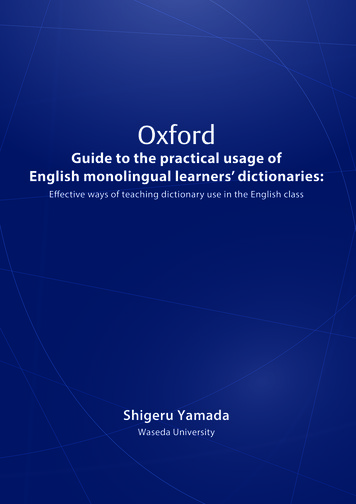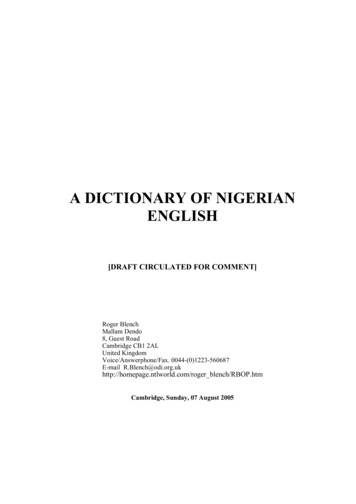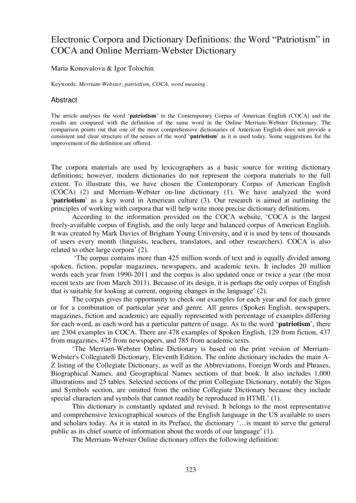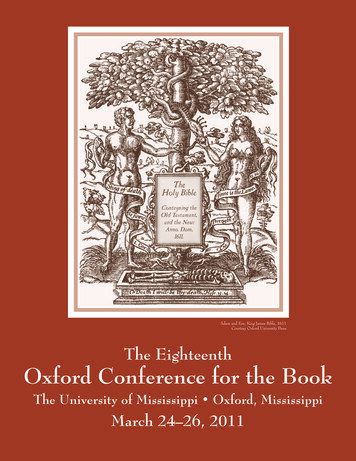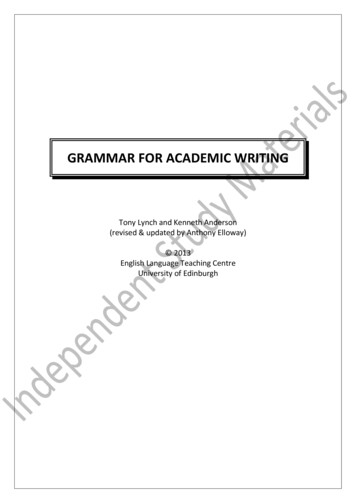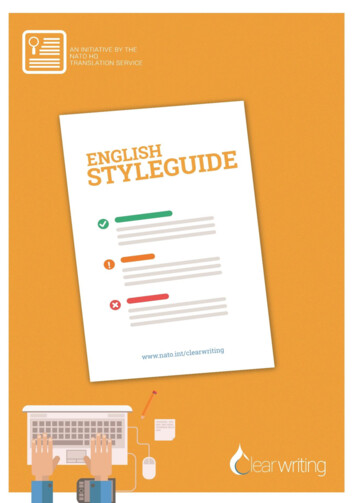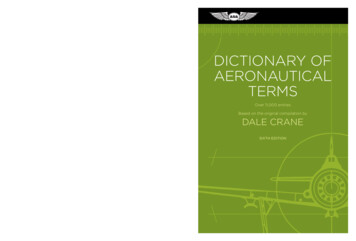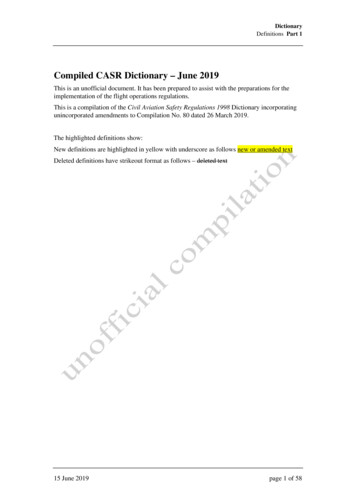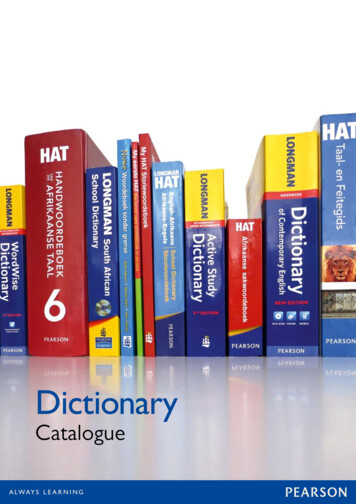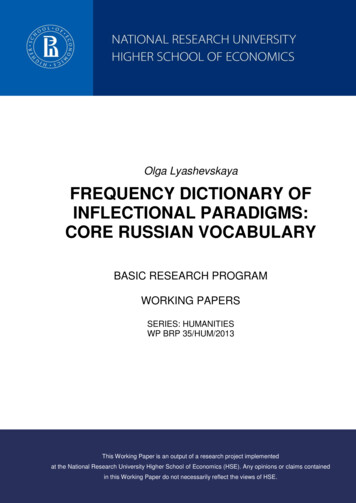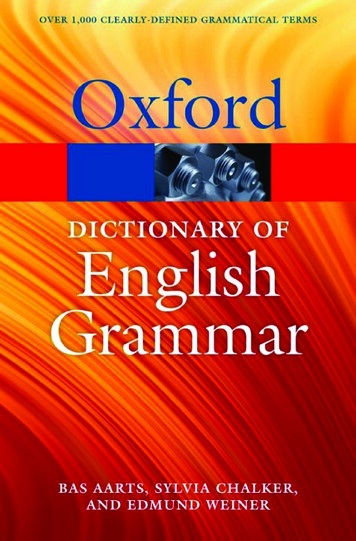
Transcription
The Oxford Dictionary ofEnglishGrammarSECOND EDITIONB A S A A RT SS YL V I A C H A L K E REDMUND WEINERBas Aarts is Professor of English Linguistics at University CollegeLondon. He has published many books and articles on Englishgrammar, most recently the Oxford Modern English Grammar.The late Sylvia Chalker was the author of several grammarbooks, including Current English Grammar and the Little OxfordDictionary of English Grammar. She was also a contributor tothe Oxford Companion to the English Language.Edmund Weiner is Deputy Chief Editor of the Oxford EnglishDictionary and co-author (with Andrew Delahunty) of the OxfordGuide to English Usage.AThis is a web-linked dictionary. There is a list of recommendedweb links in the Appendix, on page 454. To access the websites,go to the dictionary’s web page at www.oup.com/uk/reference/resources/englishgrammar, click on Web links in the Resourcessection, and click straight through to the relevant websites.
3Great Clarendon Street, Oxford, OX2 6DP,United KingdomOxford University Press is a department of the University of Oxford.It furthers the University’s objective of excellence in research, scholarship,and education by publishing worldwide. Oxford is a registered trade mark ofOxford University Press in the UK and in certain other countriesOriginal material: # Sylvia Chalker and Edmund Weiner 1994New and revised material: # Oxford University Press 2014The moral rights of the authors have been assertedFirst edition published 1994First issued as an Oxford University Press paperback 1994Reissued, with corrections, in new covers 1998Second edition published 2014Impression: 1All rights reserved. No part of this publication may be reproduced, stored ina retrieval system, or transmitted, in any form or by any means, without theprior permission in writing of Oxford University Press, or as expressly permittedby law, by licence or under terms agreed with the appropriate reprographicsrights organization. Enquiries concerning reproduction outside the scope of theabove should be sent to the Rights Department, Oxford University Press, at theaddress aboveYou must not circulate this work in any other formand you must impose this same condition on any acquirerPublished in the United States of America by Oxford University Press198 Madison Avenue, New York, NY 10016, United States of AmericaBritish Library Cataloguing in Publication DataData availableISBN: 978–0–19–965823–7Printed in Great Britain byClays Ltd, St Ives plcLinks to third party websites are provided by Oxford in good faith andfor information only. Oxford disclaims any responsibility for the materialscontained in any third party website referenced in this work.
ContentsPreface to the First EditionvPreface to the Second EditionOrganizationviiNotational seful Web Links454ixvi
Preface to the First EditionGrammar, etymologically speaking, is related to glamour. Though few people mightclaim that grammar is glamorous in the modern sense, there is considerable interest inEnglish grammar today and no shortage of grammar books, ranging from small basicbooks aimed at children or elementary-level foreign learners, through more advancedmanuals to large scholarly works. The trouble is—they may be about the same language,but they do not always speak the same language. The very range of the grammar bookson offer presents problems.There are many ways of describing grammar, and a wealth of terminology. Some of itstrikes the layman as jargon (disjunct, matrix, pro-form, stative); other words appearordinary enough but conceal specialized meanings (comment, focus, specific). Worse, thesame terms, old or new—comparison, formal, pronoun, reported speech, root, stress—areused by different grammarians with different meanings.Such difficulties are not entirely avoidable. Any subject of study needs specialistwords. Different grammarians are entitled to analyse language in different ways, andfresh viewpoints may call for new terms. But while grammarians sometimes explainwhat they mean by a new or unusual term, it is rarer for them to point out that theyare using an existing term in a different way. This is a cause of real confusion. Anotherproblem is that new terms may in the end turn out simply to be alternatives for an oldconcept—a synonym in fact (e.g. progressive, continuous).We have tried in this dictionary to indicate the range and variety of meanings thatmay lie behind a single term. The main emphasis is on the terminology of currentmainstream grammar, but we have also included a considerable number of entries onthe related areas of speech and meaning—more grandly known as phonetics andsemantics. Users will also find some terms from Generative Grammar, which hasgreatly influenced mainstream grammar in recent years—but some of the moretheoretical terminology of linguistics and semantics is excluded. We have also on thewhole excluded outdated grammatical terminology, apart from a few traditional termswhich may be familiar to the general reader.The authors would like to thank Professor Flor Aarts, of the Katholieke Universiteit,Nijmegen, who read an early draft of the book: his comments, we believe, have led tomany improvements, but the authors are alone responsible for any blemishes thatremain. We would also like to thank our families for their support, encouragement,and, at times, forbearance.scescwLondon, Oxford 1993
Preface to the Second EditionStudents of English are faced with an ever-expanding list of terms when studying thegrammar of present-day English. The Oxford Dictionary of English Grammar offers helpby defining current terminology clearly with the help of numerous example sentencesand quotations from the scholarly linguistic literature. Where the same terminology isused differently by linguists, these differences are explained, and where differentterminology is used in the same way, this is also clearly signalled.This new edition of the Oxford Dictionary of English Grammar differs from the firstedition in many ways: All entries have been completely revised and updated. There are many new entries covering recent terminology, for example from TheCambridge Grammar of the English Language. There are new short entries on the most important grammars of English publishedsince the beginning of the twentieth century. Usage advice is given where appropriate, though it is never prescriptive. Advice is sometimes given regarding the use of terminology that most linguists wouldagree is best avoided.Readers familiar with the first edition will notice that the entries on English phoneticshave been removed. The reason for this is that it is very unusual for phonetics to becovered under the heading of ‘grammar’, and this terminology is best dealt withelsewhere.The term ‘grammar’ is conceived of in this dictionary as encompassing syntax andmorphology, and the aim is to cover terminology that is used in the current literature onEnglish grammar. The dictionary also has entries on related fields of study, such ascorpus linguistics, historical linguistics, lexicology, (lexical) semantics, sociolinguistics,stylistics, and so on, but only when this terminology is broadly relevant to grammar.Terms from theoretical frameworks are also covered to some extent, especially thosefrom Generative Grammar and Systemic Grammar, though for a fuller treatment thereader is referred to Peter Matthews’s Concise Oxford Dictionary of Linguistics.I am grateful to the late Sylvia Chalker and to Edmund Weiner for their excellentwork on the first edition of this book, and to Rebecca Lane and Jamie Crowther at OUP fortheir support during the writing process. Finally, thanks are due to Jill Bowie for hermeticulous copy-editing and to Donald Watt for proofreading.bas aartsUniversity College London
Organization1. Entries are strictly alphabetical. Thus:agentagentiveagentless passiveagent noun2. Cross-references to other entries are signalled by an asterisk when they occur inrunning text, e.g.AktionsartThe lexical expression of *aspect . . .3. In formal cross-references, the entry referred to is indicated in small capitals, e.g.focusing subjunct See focusing adverb.A cross-reference to a phrase listed within an entry is given in a mixture of smallcapitals (for the entry headword) and italics (for the remainder of the phrase),e.g. complex sentence.4. When a cross-reference relates to a particular numbered sense in another entry, thenumber of the relevant sense is indicated, e.g. *base (2) or base (2).5. Where a word is not a grammatical term in itself, but forms part of a phrase which isdealt with elsewhere, this is indicated, e.g.act See speech act.6. Where a term is dealt with at the entry for some larger term, this is indicated, e.g.formulaic subjunctive See subjunctive.7. Where two or more terms are synonyms, the definition appears under the preferredterm, usually with a reference to the alternative term, e.g.folk etymology. . . Also called popular etymology.and the other term is cross-referenced with an asterisk, e.g.popular etymologyThe same as *folk etymology.8. Where two or more terms are in a contrastive relationship, this is stated at thebeginning of both entries, e.g.abstract . . . . . Contrasted with *concrete.concrete . . . . . Contrasted with *abstract.9. See (also) at the end of (part of) an entry indicates that further information will befound at the entry indicated. Sometimes the user is referred to a closely relatedword, e.g.coordinate . . . . . See also coordination.At other times the reference is to a ‘background’ concept, e.g.discord . . .
Organizationviii. . . See agreement.10. Compare at the end of (part of) an entry indicates that although the entry iscomplete, it may be useful to read entries for related or overlapping terms, or termswith which this term could be confused, e.g.abbreviated . . . . . Compare block language; reduced clause.These particular entries show that certain types of language that mightreasonably be described as abbreviated are in fact given special labels.11. Words are marked with word class labels (n. noun, adj. adjective,v. verb, etc.) only when they can belong to more than one class.12. Where word class labels are conjoined (e.g. n. & adj.), the definition is framedso as to cover both uses, with parentheses surrounding the part of the definitionthat applies to only one of the two uses, e.g.countable(n. & adj.) (Designating) a noun with singular and plural forms.which is equivalent to:(n.) A noun with singular and plural forms.(adj.) Designating a noun with singular and plural forms.13. In certain entries, words and phrases quoted as examples are given abbreviated datesindicating their earliest known recorded appearance in English. In these, the numberis that of the century and the preceding E, M, L mean ‘early’, ‘mid’, and ‘late’: ‘E19’means ‘1800–1829’, ‘M19’ means 1830–1869’, and ‘L19’ means ‘1870–1899’. OEmeans ‘Old English’ (before 1150), ME ‘Middle English’ (1150–1349), and LME ‘lateMiddle English’ (1350–1469).14. In many entries, quotations from works on language and linguistics are given inorder to illustrate the use of the word being defined. Only the author’s name and thedate of the work are cited: fuller details are given in the References section.15. Meanings are signalled by single inverted commas: e.g. Wherever you go, you’ll becovered by this insurance (‘No matter where you go . . . ’).16. Derivatives of a headword are listed at the end of the entry and indicated by a singlepreceding dot. They are undefined if their meaning is plain once that of the parentword is known, and if they are not found in ‘extended terms’ (special phrasalcombinations). For example, at the end of the entry for syntax we have: syntactic, syntactically.17. Extended terms are listed alphabetically at the end of the entry following anyderivatives, and indicated by two preceding dots. They are given brief definitions orfuller discussion as appropriate. For example, in the entry for modifier we have: modifier clause: a clause that postmodifies a head, e.g. a *relative clause. sentence modifier: a modifier that modifies a complete sentence or clause.
Notational Conventions*?ØarrowsAn asterisk used before a citation of a linguistic form indicates animpossible structure, i.e. a structure that does not conform to thegrammatical rules of English. Example: *They likes to read. In thisexample the third person plural subject they is followed by a verb with athird person singular inflectional ending.A question mark used before a citation of a linguistic form indicates astructure that is of doubtful acceptability. Example: ?Give it me.This symbol is used to indicate an implicit subject. Example: I want [Ø toread it].These indicate movement, For example, in What did you see? thepronoun what functions as the direct object of the verb see and has beenmoved to the beginning of the sentence to form an interrogativestructure:What did you see ?The underscore symbol is explained below.brackets [ . . . ]co-indexingitalicsBrackets are used:(1) to indicate words that together form a constituent phrase, clause, etc.A labelled bracketing includes a subscript indicator of the syntacticstatus of the constituent. Example: [NP Cats][VP eat [NP fish]];(2) to indicate that a lexical item, usually a verb, is followed by acomplement which contains a particular word. Example: have [to]indicates that the verb have is followed by a complement that containsthe word to, e.g. I have to leave.Items that are co-referential can be co-indexed, i.e. bear the samesubscript letter, usually an ‘i’. Example: Hei shaves himselfi twice everyday.These are used:(1) to cite words, sentences, etc. as linguistic forms;(2) to indicate words, phrases, etc. that require highlighting.For underlined italics, see below.underlineditalicsWithin italicized citations of linguistic forms, underlining is used tohighlight particular words (or other elements) for attention.underscore(‘ ’)This symbol indicates a ‘gap’ in the clause with which a displacedelement is associated. For example, in What did you see ? the pronounwhat has been moved to the beginning of the sentence from the positionindicated by ‘ ’ to form an interrogative structure.
AbbreviationsA/AP (or GP/PPSV/VPadjective/adjective phraseadverb/adverb phraseAmerican EnglishBritish EnglishThe Cambridge grammar of the English language, by Rodney Huddleston, Geoffrey K. Pullum, et al. Cambridge:Cambridge University Press, 2002.A comprehensive grammar of the English language, byRandolph Quirk, Sidney Greenbaum, Geoffrey Leech, andJan Svartvik. London: Longman, 1985.determinative/determinative phrase (or determiner/determiner phrase)determinative (or determiner)Direct ObjectIndirect Objectnoun/noun phraseOxford Modern English grammar, by Bas Aarts. Oxford:Oxford University Press, 2011.preposition/prepositional phrasesentenceverb/verb phrase
AA *Adverbial as an *element of *clause structure.The symbol is used in some modern analyses of clause structure(e.g. CGEL). See adverbial (1).Compare c; s; o; v.See also adjunct.A-bar category See x-bar syntax.abbreviated Shortened or contracted so that a part stands for thewhole.This term is used to designate language (a clause, phrase, word, etc.) inwhich words inessential to the message are omitted and the grammarsometimes deviates from standard rules. It is a very general term, sinceindividuals will vary in how severely they abridge, and exactly how theydo it when writing diary entries, notes, etc.Abbreviated sentences of a more predictable kind are a frequentfeature of informal writing (e.g. text messages, handwritten notices) andconversation. Here the subject and part of the verb are often omitted.Having a wonderful time hereSee you soonAll news thenBack at 5More tea? ( Would you like . . . ?, Do you want . . . ?)Abbreviated language overlaps with *ellipsis, but is less subject toconstraints. For example, there is no need for the ‘missing words’ to be‘recoverable’.Labels and printed instructions, too, often use abbreviated language;and here not only subjects but objects also are typically omitted, e.g.Contains natural herb extractsAvoid getting into the eyesOther forms of abbreviated language appear in titles and newspaperheadlines. abbreviated clause: the same as *reduced clause.
abbreviationa2 abbreviated form: the same as *contraction (2).Compare block language; reduced clause.See also abbreviation.abbreviation A shortened form of a *word or *phrase, standing for thewhole.This term is applied in three different ways.1. A string of letters—often spoken as such—formed from the initialletters of the (main) words of a phrase. Also called *initialism, e.g.BBCCBIERMOTTPCUK(British Broadcasting Corporation)(Confederation of British Industry)(Exchange Rate Mechanism)(over the top)(personal computer)(United Kingdom)Sometimes the letters represent syllables of a word:IDTB(identity or identification card)(tuberculosis)2. A word (sometimes called a *clipping) standing for the whole, retaining at least one syllable of the original word.addemoflupubphonesitcom(advertisement) (M19)(demonstration) (M20)(influenza) (M19)(public house) (M19)(telephone) (L19)(situation comedy) (M20)Clippings vary in their level of formality; mike (microphone) and wellies(wellington boots) are at the informal end of the scale. Other abbreviationsare acceptable in formal contexts, e.g. bus (omnibus), maths (US math)(mathematics); or their origin may even be virtually forgotten, e.g. mob(from Latin mobile vulgus).3. A written convention which is unpronounceable in its shortened form.This includes abbreviations of personal titles, e.g. Col., Dr, Mrs, Sgt., etc.Also:St. (street)Fr. (French)Gk (Greek)etc. (etcetera)kg (kilogram)rpt (repeat)MS(manuscript)
absolute3There are a few special written conventions for plurals:pp (pages)ff. (following pages)MSS or mss (manuscripts)Written Latin abbreviations are sometimes read out in their Englishequivalents, but some are only pronounced as letter strings, e.g.e.g.i.e.cf.a.m. and p.m.(exempli gratia) (‘for example’, /ˌiːˈdʒiː/)(id est) (‘that is’, /ˌaɪ ˈiː/)(confer) (‘compare’, /ˌsiː ˈef/)(ante meridiem and post meridiem: /ˈeɪ ˌem/, /ˈpiː ˌem/).Chemical formulae and other symbols can be regarded as a special typeof abbreviation:H2O (water) (minus)Fe (iron)þ (plus)& (and)Compare acronym; blend; contraction; initialism.ability One of the semantic categories used in the classification of*modal verbs.The term is particularly applied to the *dynamic (2) meaning of can andcould. It contrasts with other meanings of these verbs such as *permissionand *possibility.See also modal; modality.ablative (n. & adj.) (In older grammar.) (A case) that expresses meanings such as ‘by N’, ‘with N’, or ‘from N’ (where N *noun).This case, occurring and originally named in Latin, is not relevant toEnglish, where such meanings are expressed by *prepositional phrases.The corresponding semantic categories include *agent, *instrument, and*means. The nearest equivalent in English to the ablative absolute ofLatin (ablativus absolutus) is the *absolute clause.Compare case.absolute1. (n. & adj.) (Designating) the *unmarked *degree (1) in the three-waysystem of comparing *adjectives and *adverbs (e.g. kind, soon), in contrastto the *comparative forms (kinder, sooner) and the *superlative forms(kindest, soonest). Also called plain grade or positive.2. Non-gradable. See gradable.3. Used for *possessive *pronouns that can stand on their own (mine,yours, his, ours, theirs), contrasted with my, your, etc. which are placedbefore nouns (the latter being variously analysed as pronouns or asdeterminatives (1)). Also called independent possessive pronouns.a
absolute clausea44. (In older usage.) Designating an *adjective or *verb which occurs incertain unusual constructions or syntactic relationships, e.g.(i) an adjective used without a following noun (e.g. the poor);(ii) a normally transitive verb used intransitively (e.g. Have you eaten?); and(iii) a comparative or superlative form of an adjective used without the specificmention of a relationship (e.g. I only want the best).1931 G. O. CURME The absolute comparative is not as common as theabsolute superlative . . . higher education; a better-class cafe.See also absolute clause. absolutely (in older usage, as 4(i) above.)1884 New English Dictionary In ‘the public are informed’, ‘the young areinvited’, public and young are adjectives used absolutely.absolute clause A *non-finite or *verbless *clause containing its ownsubject, attached to a sentence from which it is separated by a comma(or commas), and not introduced by a subordinator. Also called absoluteconstruction.A verb, if used, can be an -ing or an -ed/-en form. Examples:The fight to board the train—the women crushed against the doors, the childrendesperately clutching their mothers—repeated itself at this provincial stationThe platform empty once more, I settled down for the nightExcept for a few set phrases (weather permitting, present company excepted) absolute clauses tend to be formal and written. If the subjectis a pronoun it must be in the *nominative (i.e. the subjective (1)), not the*accusative (i.e. the objective (1)), case (e.g. I refusing to go, Nicholas wentalone), so absolute clauses are sometimes called nominative absolutes.(This contrasts with the *ablative absolute of Latin grammar, where thecomparable noun is in the ablative case.)See also small clause.absolutive case See ergative.abstract Used mainly of *nouns that denote an action, idea, quality, orstate; contrasted with *concrete.The traditional division of common nouns into abstract and concretenouns is semantic. It therefore cuts across the more strictly grammaticalclassification into *uncount and *count nouns. It is unsatisfactory as a wayof trying to deal with syntactic differences: the abstract label does fit manyuncount nouns (e.g. Everybody needs advice/fun/luck; not *an advice/
accidence5*funs/*two lucks), but abstract nouns also include count nouns (e.g. Wehad an idea/another quarrel/better solutions; not *We had idea/quarrel/better solution). Other abstract nouns have both count and uncount uses(e.g. several important discoveries/an important discovery; a voyage ofdiscovery). abstract case: see case.acceptability Of a language form or an utterance: the quality of beingjudged by native speakers as normal or possible.Native speakers may disagree over whether a particular *utterance isgrammatically acceptable or not. An individual’s judgement of acceptability may be affected by personal, regional, or social background, byperceptions of ‘correctness’, and so on. For example, judgements differover the acceptability of:? You ain’t seen nothing yet? She was realizing there was a problem? The house was building for three years? We convinced them to go? Either Monday, Tuesday, or Wednesday would suit meLinguists make a distinction between acceptability and *grammaticality,since sentences may be grammatically correct according to the *rules, butunacceptable for some other reason. For example, a properly constructed,grammatically correct sentence could be so long that it becomes unacceptable because it is virtually impossible to understand. In this sense,acceptability is related to actual performance, while grammaticality is afeature of (more idealized) *competence.Acceptability can extend to *word formation. Thus, although the suffix-ish, with the meaning ‘somewhat like’, ‘somewhat’, combines with concrete nouns (e.g. foolish, snobbish, kittenish) and adjectives (e.g. coldish,pinkish), there could be degrees of acceptability as regards words newlyformed with this suffix (e.g. ?yuppyish, *idiotish, ?trendyish,?*aquamarinish). acceptable.1988 R. QUIRK Characters in Dickens can use an’t or ain’t for ‘isn’t’ withoutany hint that such forms are other than fully acceptable.accidence (In older grammar.) The part of grammar that deals withthe *inflections of words; the way words change to indicate differentgrammatical roles.a
accusativea6This category traditionally contrasts with *syntax. For example, thedifferences between:drive, drives, driving, drove, and drivenor between:driver, driver’s, drivers, and drivers’would come under the heading of accidence in a traditional grammar.In more modern grammar the term has been superseded by *inflection,which, together with *derivation, is dealt with under *morphology.Apparently accidence was an alteration of accidents (plural), usedaround 1600 to mean ‘the changes to which words are subject inaccordance with the relations in which they are used’, translatingthe Latin neuter plural accidentia; although it is possible that thelatter was misunderstood as a feminine singular noun and renderedaccidence.accusative See objective (1).acquisition Linguistics. The process of learning a language.The term child language acquisition is used in descriptions of howchildren develop the ability to speak a language.See also language acquisition device.acrolect Sociolinguistics.1. A term used to describe varieties of a language in a *creole continuum. Specifically, in a particular community the acrolect is the variety thatis nearest to the standard.Compare basilect; hyperlect; mesolect.2. More generally, the most prestigious or ‘highest’ social variety of alanguage.The term is sometimes used in connection with mother-tongue Englishspeakers. Thus standard British English spoken with a standard accentmay be considered an acrolect (see also hyperlect). It is also used ofvarieties of English in regions where English is a second (or third)language.1977 J. T. PLATT I feel that in the case of Singapore English . . . a very distinctnon-British English acrolect is gradually emerging. acrolectal.acronym Morphology.1. Strictly, a *word formed from (i) the initial letters of other words,or from (ii) a mixture of initials and syllables, e.g.
active7(i) AFAIK ( as far as I know)NATO ( North Atlantic Treaty Organization)NIMBY ( not in my back yard)(ii) radaryuppie( radio detection and ranging)( young urban professional þ diminutive ending)Sometimes included in the general term *abbreviation.2. More loosely, an *abbreviation pronounced as a string of letters,especially letters that stand for the name of an organization or institution,e.g. BBC, USA.This usage may be due to the fact that the specific term for this typeof abbreviation (*initialism) is not widely known.act See speech act.action The process of acting or doing, expressed by a *verb.Many transitive verbs used in the active *voice are said to ‘act upon’their objects, which are given the *semantic role of *patient. However, notall such verbs imply actors, actions, or patients in any meaningful way (e.g.I heard screams, He contracted hepatitis).Traditionally and loosely the term is used of any verb, but this is bestavoided.1884 New English Dictionary Action of a verb, verbal action: The actionexpressed by a verb; properly of verbs which assert acting, but convenientlyextended to the thing asserted by a verb, whether action, state, or mereexistence, as I strike, I stand, I live, I am.See also case (1); case grammar; semantic role.actional passive See passive.action verb A *verb (also called an event verb) describing a *situationthat occurs over a limited period of time which has a beginning and anend, e.g. arrive, make, listen, walk. Contrasted with a *state verb.The terms *action and event, used to describe verbs, are popularequivalents for *dynamic (1). (Similarly, state verb is popularlysubstituted for stative verb.) The alternative labels are not, however,strictly synonymous, since the main verb in I am growing old, as partof a *progressive construction, must be described as dynamic, but lessobviously denotes either an action or an event.Compare dynamic; stative.active (adj.) Of a *verb, *clause, *construction, etc.: designating anexponent of the grammatical *category of *voice whereby the grammaticala
activo-passivea8*subject is the *agent of the action denoted by the verb. Contrasted with*passive.(n.) A construction (verb phrase, clause, sentence) in which the referentof the grammatical *subject typically carries out the action expressed bythe verb (i.e. is its *agent). Contrasted with passive.The term is sometimes applied to the verb itself such that the verbs inthe following examples are said to be in the active voice:The bird caught the wormThe sun rises in the eastMany verbs, e.g. intransitive verbs, can occur only in the active.1985 R. QUIRK et al. There are greater restrictions on verbs occurring in thepassive than on verbs occurring in the active. active verb: (in older usage) the same as *action verb.See also agent; by-phrase; double passive; get-passive; patient;pseudo-passive; semantic role; semi-passive; voice.activo-passive See mediopassive.actor See agent.adj-bar category See x-bar syntax.adjectival (n. & adj.) Loosely, (a *word, *phrase, or *clause) behavinglike an *adjective (including single-word adjectives); e.g. in a damp cloth,the word damp is an adjectival element.The term is also used for examples like the following:guide pricethe greenhouse effectthe man in the white suitan I’m-all-right-Jack attitudeSome writers informally use the word adjectival to describe all of theitalicized strings (or even say that they are adjectives), but this isinfelicitous, since *form and *function are being confused: the first twoexamples involve nouns as *modifiers; the third example involves a*prepositional phrase; and the final example has a clause as modifier.Note that the terms adjectival and *adverbial are not entirely comparable. Adverbial can denote one of the main *elements (1) in clausestructure (the others being *subject, *verb, *object, and *complement); it isthen a function label. Adjectivals operate at a lower level, often as part of ano
Grammar, etymologically speaking, is related to glamour. Though few people might claim that grammar is glamorous in the modern sense, there is considerable interest in English grammar today and no shortage of grammar books, ranging from small basic books aimed at children or
